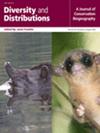Hindcasting long-term data unveils the influence of a changing climate on small mammal communities
Abstract
Aim
Shifting climates are reshaping ecosystems globally and are projected to intensify over the coming century. Understanding how biodiversity will respond to these shifts is crucial for developing effective climate adaptation measures. We generate predictive models built from long-term data to hindcast historic fluctuations in small mammal abundances as they have responded to shifting rainfall and fire conditions. This data set serves as the basis for predicting historical variations (hindcasting) in small mammal abundances, allowing us to examine their responses to decadal changes in fire and rainfall conditions within our study landscape.
Location
Australia (Victoria).
Taxa
Small mammals (Mammalia).
Time Period
1970–2022.
Methods
Small mammal abundance was surveyed at 36 long-term trapping sites and modelled against coinciding fire history, vegetation productivity and rainfall using generalized additive mixed models. Six species were then used in predictive modelling against these variables for the decades preceding our monitoring programme (1970–2007).
Results
All species abundances increased with higher rainfall. Time since fire was also an important variable in all but one species model, with species displaying varying responses to time since fire. Hindcasting predictions for small mammal abundances varied with some species showing marked declines over time. Clear trends emerged, indicating more volatile population fluctuations in response to intensified fire and rainfall extremes in the 21st century. This suggests that periods of higher rainfall and less frequent fire events in the decades preceding our monitoring period supported higher and more stable small mammal abundances.
Conclusions
Native species show distinct sensitivity to the combined effects of drought and fire, which has occurred in recent times. Intensification of these drivers has caused increased volatility in small mammal abundances with low abundance extremes occurring more frequently.


 求助内容:
求助内容: 应助结果提醒方式:
应助结果提醒方式:


